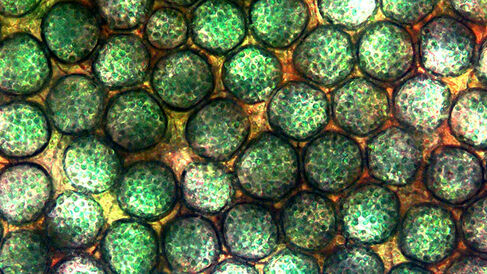
The Howe Group and collaborators have published a new paper in Nature Communications.
Tobias Wenzel, Daniel Haertter, and Ulli Steiner (now at the Adolphe Merkle Institute, Fribourg, Switzerland) of the Cavendish Laboratory, collaborating with Paolo Bombelli and Chris Howe of the Biochemistry Department, have published a paper using 3D-structured electrodes to enhance current production from photosynthetic bacteria.
Photosynthetic microorganisms produce small amounts of electrical current, which can be harvested using suitable electrodes in 'biophotovoltaic' devices functioning as biological solar cells. Paolo Bombelli has led a project in Chris Howe's group for several years to understand both how these currents are produced and how to enhance them. Recent advances have seen the use of graphene as an electrode material,1 the enhancement of power output by separating the processes of current output and harvesting,2 and using inkjet printing of cells onto paper-based electrodes.3
The latest work shows that the nature of the electrode surface plays an import role in determining current output. Cells on electrodes based on the conductive material indium tin oxide with a structured 'nanoporous' surface (containing nanometre-scale pores) gave currents 100 times higher than cells on completely flat electrodes. Increasing the size of the pores to make 'microporous' electrodes containing micrometre-scale pores, which cells could enter, gave a further but more modest increase. These results demonstrate the importance of the structure of the electrode surface, and also provide insights into the mysterious process by which electrons are actually transferred to the electrodes.
The authors hope that the work will help in making biophotovoltaic devices that can be used for real-world applications, such as biosensors, living cell-electronics interfaces, or power generation in off-grid locations where modest amounts of power can make a big difference.
1Call et al., J. Mat. Chem.5:23872 (2017). You can read our blog article here.
2Saar et al., Nat. Energy 3:75 (2018). You can read our blog article here.
3Sawa et al., Nat. Comms.8:1327 (2017). You can read our blog article here.
